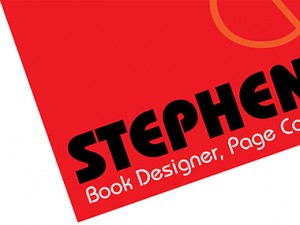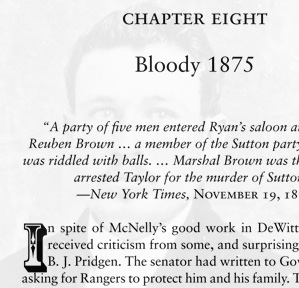 When we originally posted our call for self-published authors for our series, we never thought we’d hear from someone like Stephen Tiano. Stephen isn’t a self-published author, but an experienced book designer who has vast experience in the industry and truly loves his craft. While we didn’t necessarily set out looking to interview a book designer, I’m sure glad we did! Stephen’s enthusiasm for the interview concept and passion for book design and layout artistry truly are an inspiration, and his views are a great read for everyone involved in the self-publishing process. Now, on to the interview:
When we originally posted our call for self-published authors for our series, we never thought we’d hear from someone like Stephen Tiano. Stephen isn’t a self-published author, but an experienced book designer who has vast experience in the industry and truly loves his craft. While we didn’t necessarily set out looking to interview a book designer, I’m sure glad we did! Stephen’s enthusiasm for the interview concept and passion for book design and layout artistry truly are an inspiration, and his views are a great read for everyone involved in the self-publishing process. Now, on to the interview:
About Stephen & Background
- Exactly what services do you provide for self-published authors?
- I am a freelance book designer, page composition artist, and layout artist. (I know because it says so on my last business card.) I can either work with a client’s design ideas for how they want their book to look, they can leave it completely in my hands, or we can interact together on the project.
- How long have you been working with the writing crowd?
- Although I started doing page layout for publishers and book production houses 17 years ago, graduating to book design, too, over those years, my first project for a self-publisher was only about five years ago. Over the last year or so and to the present, I’ve been getting a steady flow of self-published book projects.
- Why did you decide to work exclusively in book design?
- Well, having started as a proofreader and copy editor, I had a clear sense of how words on the printed page should look. Although my very first production work on the computer was resumé design and even some in-house adwork, books were what I loved. And one extended experience, proofreading at a poorly-run sort of typesetting factory, gave me the impetus every single day to say things like, “If I had the proper tools, I could set type myself at home.” Once those tools—personal computers and PageMaker, initially—became available for individuals to do design and layout work, I gravitated into it. I started doing layout for publishing companies. They generally had housestyles to adhere to. It was sort of like paint-by-numbers, but it gave me a look at how things were typically done. When I began to get design and layout projects, I was able to consider more interesting ways for text in print to look.
- Have you done any work for clients other than authors in the past? If so, what are the key differences in working with authors vs. others?
- Well, as I said, I first worked for publishing companies. There, most of the time, especially since I was just cutting my teeth, I was following someone else’s (usually long-used) design. I also came to do some book design for a few publishers. Working for self-publishing authors, however, allows for greater creativity. Of course, the responsibility is quite a bit different when working for a self-publisher. It’s like you’re right down in the foxhole with him or her, answering their questions directly. But for one time, I don’t remember ever dealing directly with an author when working for a publishing company or production service.
On The Self-Publishing Process
 What’s the most common misconception that you see that authors have about the self-publishing process?
What’s the most common misconception that you see that authors have about the self-publishing process?
- I haven’t really had that kind of experience yet with an author. They all seem really well-grounded and appear to have done their homework, and have considered and investigated how the process works. Most of them are not terribly familiar with how I do my work for them, but they understand that we are piecing together the process to make a book from their ideas and words.
- How important do you think design is to self-publishing success?
- I tell authors that the last statistic I’ve seen suggests that nearly any self-published book can expect to sell less than 200 copies (mostly to family and friends). So the most important task for them is to identify what I call their “natural audience,” readers who are most likely to have an interest in what they’ve written about. The designer, then, is the connector between, first, that “natural audience,” and their book and, after that, the at-large reader who might just be browsing a bookstall. After that, it’s a matter of attracting potential readers into picking up their book and hoping the subject matter and the writing will somehow “hook” these potential readers. And although what a book is about and how it is written will ultimately decide whether a reader continues reading to the book’s end, the designer baits that hook to attract readers and can influence how pleasureable the act of reading it is. Make no mistake, if a reader is unsure of whether they like what they’re reading, an uncomfortable reading experience will be a nail in the coffin of whether they finish reading that book.
- Of the major self-publishing houses, do you prefer to work with any one in particular?
- Do you mean, essentially, the printers—POD print-on-demand, outfits—that print self-published books? [AN: Yes, exactly. POD printers such as Lulu or Createspace]. Sometimes, of course, these places provide a whole host of services from editing through production and even marketing. But those are sometimes like dropping money into a hole, as they’ll sell all kinds of packages and services that can make the process very, very expensive.
- In your experience, how does the print quality compare among self-publishers? How does it com-pare to traditional offset printing?
- I don’t generally get involved with the printing process, except to occasionally get certain technical specs—the width the spine needs to be, for instance, given the numbr of interior pages and the paper the book wil be printed on.
- Could you share a particular client experience you’ve had that authors could learn from?
- A few years back I worked a book layout—another designer had created the book’s design—but it was that designer first book design project. Between the author making changes to her text throughout the time I worked laying out pages and the designer’s not knowing when to say her vision was complete, they paid me an enormous amount for corrections and changes—twice as much for them as for the initial layout. I think that’s just a terrible way to lose control of a budget. As it happened, for that one I worked for a book packager, not a self-publishing author, so that makes it doubly horrendous. Amateur hour all the way around from an established outfit that should have known better.
On Design
 What’s your favorite part of the overall design process?
What’s your favorite part of the overall design process?
- Beginning a project. Sitting down and looking over the text materials and any art (illustrations, photos, charts, etc.) in the book and brewing my first ideas on how to present that material and make a book out of all of it.
- In terms of design, what is the most common mistake made by self-published authors?
- Thinking that the kind of “pennywise-poundfoolish” one-size-fits-all templates some of the POD services and vanity outfits provide is sufficient book design.
- Give us a general outline of your “dream” client versus your “nightmare” client.
- My dream client has a well-written book about a subject that people are currently interested in. He or she has a clear picture of who their initial potential readers are, after friends and family, and an idea how they will find those potential readers. This client has also investigated the printing process and possesses some idea of what page sizes are considered “standard” and how veering from such standard sizes can affect their costs. He or she doesn’t know a lot about and is not particularly interested in typefaces; but they will look over samples and be able to express a quick visceral response as to what they like from those I’ve selected as possibilities for their book. A nightmare client would be one that does not know when to let go of my part of the process.
- What would you like authors to know about design?
- That I understand it’s not a cure for cancer, but—on the other hand—design is the way they present their wordsmithing to paying customers. It’s an investment in their own work, not merely an expense. Further, the point of book design is to present their work, not distract the reader from it.
- In your opinion, what makes a successful book cover design? What makes a successful layout design?
- The point of a book’s cover is to persuade a potential reader to walk across a room when he or she spies it on a shelf and to induce that potential reader to pick up that book for a look. The cover should suggest what’s inside, both in terms of what the book has to say and the set-up, the look, of the interior pages. I sometimes say the cover makes certain promises that it’s up to the interior pages to keep.
- Which do you think is most important: layout or cover design?
- Well, I actually think they’re equally important, two parts of the whole, as I described above.
Additional Thoughts
- How do you think the emergence of the Internet has changed the landscape of publishing?
- I think it’s largely responsible for the growth of self-publishing, as it’s publicized the concept in a way most of us had never heard. Via online forums and maillists, social networking groups, and Twitter, it also allows authors, publishers, editors, designers, and artists to come togther to exchange ideas and connect in a way never before possible. The world has become small. I rarely, if ever, work for people in my own neck of the woods, Long Island, and instead have had clients from Florida, DC, the Boston area, and the midwest. I have had two from Long Island and two more from NYC (20 years apart).
- Please share any additional thoughts/comments you have on design or the self-publishing process.
- Book design, I think, is particularly important with self-published works, as getting into bookstores (both online and brick-and-mortar) is so much more work-intensive.
Duolit Details Hot Seat
And now, a bit of lighthearted randomness. We threw some rapid-fire questions at Stephen to learn a little bit more about him, outside of his thoughts on design and self-publishing.
 What’s the last book you read?
What’s the last book you read?
- My Life with the Taliban, because it’s important for me to learn about those I don’t understand.
- If you could be any fictional character, who would you be?
- Benjamin Braddock, if only to learn where that bus took them and what became of them.
- Name five people you’d most like to meet.
- Sandy Koufax, Bob Dylan, Thomas Jefferson, Steve Jobs, and Salman Rushdie.
- What piece of technology can you absolutely NOT live without?
- Computer equipment, meaning all the gear I currently have: a 24” iMac desktop system with a second, 23-inch monitor; a laser printer; a color inkjet; an iPod Touch; and the latest, just-purchased, not-yet-received, iPad.
- What’s your favorite junk food?
- Taco Bell
- Answer the age-old taste bud conundrum: chocolate or vanilla?
- Vanilla
- In the movie of your life, who would play the lead role?
- Sean Connery, without the accent.
- What’s your favorite TV show?
- All-time: The West Wing. Currently: 30 Rock.
- Pencil, pen or computer?
- Computer
- What’s your beverage of choice?
- Guinness or diet iced tea
Thanks for a great interview, Stephen! To learn more about Steve, visit his website or tweet/follow @StephenTiano.
Talk Back
Do you have any additional questions for Stephen? Did he bring up anything you’d like to discuss? Let us know in the comments!
PS – If you’re interested in being interviewed for the series, just let us know in the comments or by contacting us.
 We're
We're 









Pingback: Happy Monday, Newcomers! | Self Publishing Team | Duolit()